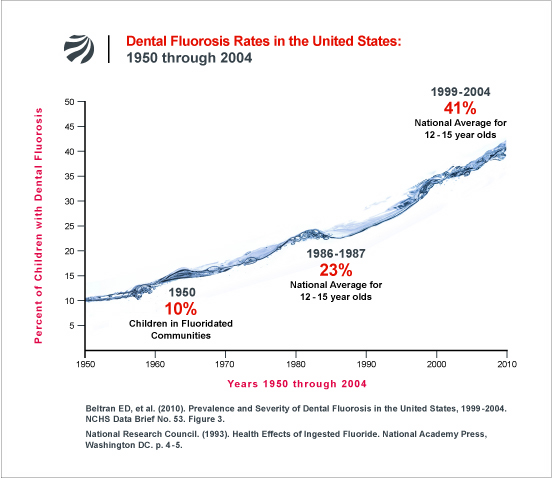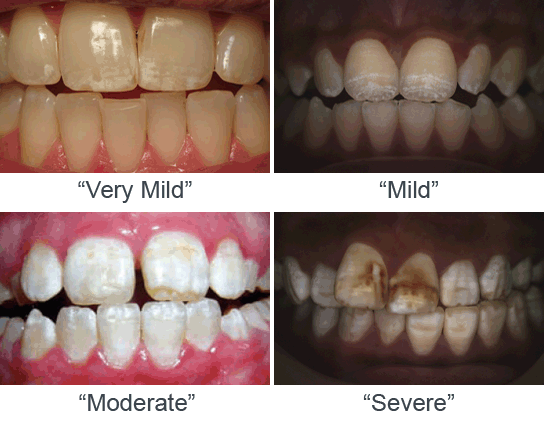Dental Fluorosis, 치아불소증
"Common sense should tell us that if a poison circulating in a child's body can damage the tooth-forming cells, then other harm also is likely."
- Dr. John Colquhoun (1997).
어린이의 몸속에 치아를 형성하는 세포에 해로운 어떤 독성물질이 돌아다닌다면 신체의 다른 부위에도 해로울 이라는 것은 상식입니다.
Do your teeth, or your child’s teeth, have white spots? white streaks? cloudy splotches? brown stains? pitting? If so, you or your child may be among the millions of Americans who now have a condition called dental fluorosis.
당신과 당신 아이의 치아에 흰색 반점 , 줄, 갈색 침착물 같아 보이는 것들이 있다면 '치아불소증'일 확률이 높습니다.
Fluorosis is a defect of tooth enamel caused by too much fluoride intake during the first 8 years of life. Although fluorosis can be cosmetically treated, the damage to the enamel is permanent. Common causes of fluorosis include: fluoridated drinking water (particularly during infancy), ingestion of fluoride toothpaste, use of fluoride tablets, and consumption of processed foods made with fluoridated water.
치아불소증은 심미적으로 치료가 불가능것은 아니지만 에나멜(법랑질)손상은 영구적입니다. 불소증의 원인은 불소가 들어있는 물, 불소치약이나 불소 타블렛의 음용, 불소가 들어 있는 물을 이용한 조리를 통한 섭취 등입니다.

Fluorosis Rates Are on the Rise
치아불소증이 증가하고 있습니다.
Before the widespread use of fluoride in dentistry, dental fluorosis was rarely found in western countries. Today, with virtually every toothpaste now containing fluoride, and most U.S. water supplies containing fluoride chemicals, dental fluorosis rates have reached unprecedented levels. According to the latest national survey by the Centers for Disease Control, 41% of American adolescents now have some form of fluorosis — an increase of over 400% from the rates found 60 years ago. (CDC 2010)
수돗물을 불소화의 최초 시행국인 미국에서 60년전 보다 불소증이 400%이상 늘었고 계속 증가 추세에 있습니다.
What Is Fluorosis?
Dental fluorosis is a defect of the teeth marked by increased porosity of the enamel (a condition known as “hypomineralization“). In the “moderate” and severe forms of fluorosis, the enamel’s porosity increases to such an extent that the teeth can begin to erode and crumble. Teeth with moderate and severe fluorosis also have very pronounced staining which can deeply disfigure a child’s smile.
Fluorosis & Self-Esteem
Children with dental fluorosis can suffer significant embarrassment and anxiety over the appearance of their teeth. No matter how much they might brush and floss, the fluorosis stains do not go away. In cases of severe fluorosis, a child may be perceived as having “dirty” or “rotten” teeth, which can cause significant damage to a child’s self esteem and emotional well-being. Even “mild” fluorosis — particularly when present on the front two teeth — can be highly objectionable. Indeed, although fluoride advocates used to downplay the esthetic effect of mild fluorosis, studies since the 1990s have repeatedly found that the general public views such teeth as less pleasing, less attractive, and more likely to cause embarrassment to the affected child than normal, non-fluorosed teeth. It is currently estimated that water fluoridation causes cosmetically objectionable fluorosis in 2 to 12% of the population.
Fluorosis: A Visible Sign of Systemic Toxicity
불소증은 만성독성이 눈에 보이는 증상
The cosmetic and psychological effects of fluorosis are significant. Dental fluorosis is not limited, however, to cosmetic concerns. The teeth are not the only tissue in the body that accumulate fluoride (the bones, pineal gland, and arteries accumulate it as well). There is no apparent reason, therefore, why fluoride’s effects on the body will be limited to the teeth. As noted by Dr. Hardy Limeback, “it is illogical to assume that tooth enamel is the only tissue affected by low daily doses of fluoride ingestion.” According to the late Dr. John Colquhoun, “Common sense should tell us that if a poison circulating in a child’s body can damage the tooth-forming cells, then other harm also is likely.”
In one study, for example, a British researcher found that the cells in the pineal gland (a gland that contains calcified deposits that accumulate fluoride) were just as susceptible to fluoride-induced toxicity as the tooth-forming cells. Unlike the teeth, however, the pineal gland cannot be seen by the naked eye. As noted by the researcher, “The safety of the use of fluorides ultimately rests on the assumption that the developing enamel organ is most sensitive to the toxic effects of fluoride. The results from this study suggest that-the pinealocytes may be as susceptible to fluoride as the developing enamel organ.” (Luke 1997).
Resources:
- Pictures: To see more photos of dental fluorosis, click here.
- Personal Stories: To read letters from individuals and families impacted by dental fluorosis, click here.
- Research: To read research on dental fluorosis, including studies documenting the increase in its prevalence and the impact it can have on a child’s self-esteem, click here.
- Diagnosis: To see the diagnostic criteria for “very mild,” “mild,” “moderate,” and “severe” fluorosis, click here.
- Treatment Options: To learn more about the options for cosmetically treating fluorosis, click here.
충치예방효과가 있다는 불소, 과유불급입니다.
문제는 그 누구도 얼만큼의 불소가 인체에 유해하지 않은지 기준을 제시하지 못하고 있다는 것입니다.
'충치예방(치아재광화)' 카테고리의 다른 글
| 시린이 치료, 시린이 증상, 치아지각과민증상엔 아파프로 나노케어! (0) | 2017.12.15 |
|---|---|
| 나노 하이드록시아파타이트(아파프로 나노케어)를 이용한 치아재광화, 치면수복, 충치예방, 치아노화방지 치료 (0) | 2017.12.15 |
| 충치예방, 손상 된 치면 수복, 치아노화방지엔 아파프로 (0) | 2017.12.08 |
| 아파프로 나노케어 후 환자의 평가(일본) (0) | 2017.12.08 |
| 나노 메디칼 하이드록시아파타이트, 신개념 치면수복및 충지예방! 아파프로 (0) | 2017.12.04 |




